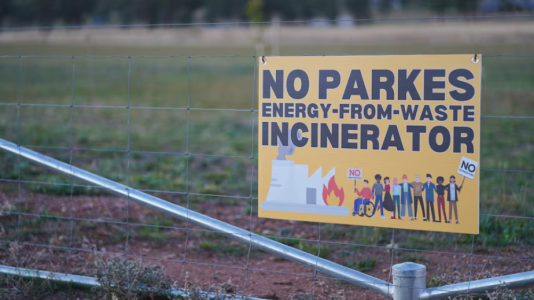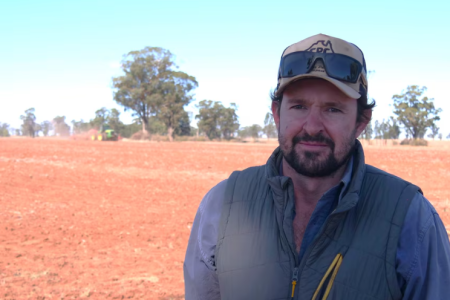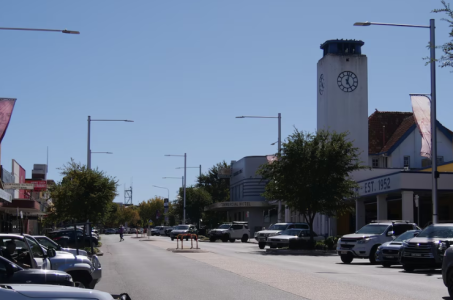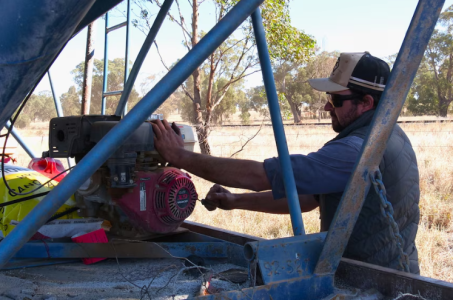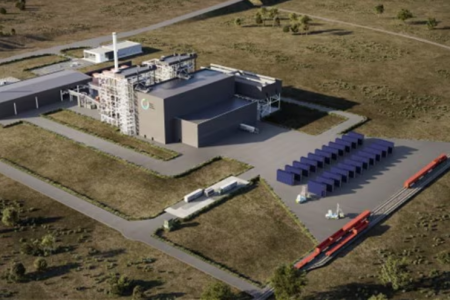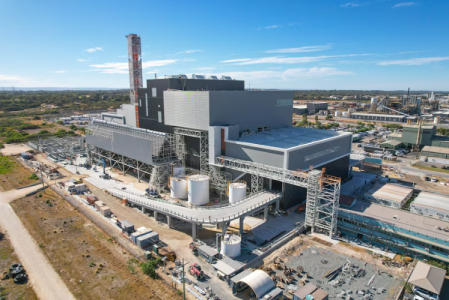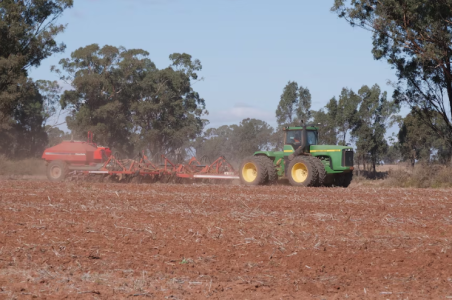Parkes residents oppose plans for $1.5b waste incinerator over health concerns
By
ABC News
- Replies 0
Jeromie Fitzpatrick never thought he would leave his farm in the New South Wales central west.
But the proposed construction of a $1.5 billion waste-to-energy incinerator on the outskirts of Parkes has him, and many in the community, reconsidering.
"It is raising some serious questions as to my future, my family's future," Mr Fitzpatrick said.
"Questions that I didn't think I would ever have to think about."
The Parkes Energy Recovery facility would have the capacity to turn 600,000 tonnes of waste into energy each year with the ability to power 80,000 homes.
The vast majority of rubbish, which is non-recyclable, would be transferred from Sydney to Parkes via train.
It has prompted thousands of locals to join a campaign demanding to know why waste from the city should be transported more than 350 kilometres to the rural community.
Why here?
A similar facility was proposed for Eastern Creek in Sydney in 2018, however, the Independent Planning Commission knocked back the proposal due to health concerns.
In 2022, the NSW government passed legislation banning waste-to-energy facilities in all bar four locations across the state, with Parkes, Lithgow, Goulburn and Richmond the only exemptions.
Ben Stead has launched a community group, the Parkes Clean Future Alliance, with a petition in opposition to the project gathering thousands of signatures.
"How is it safe here but not everywhere else?" Mr Stead said.
"What they call towns and areas like us is a sacrificial community, the smaller, lower socio-economic communities that they push these things onto."
Mr Stead said concerns over the impact of the incinerator had forced him to rethink his plans to build a house near the site of the proposed incinerator.
The facility would see 60 train loads of rubbish from Sydney per day transferred to the proposed facility at the Parkes Special Activation precinct, which is owned by the state government and located 3km out of town.
Mr Fitzpatrick's farm is less than 10km from the site.
He said if the technology "is so safe" then the facility should be built in the city.
"If it is not good enough in Sydney and Eastern Creek because it is too dangerous for the community … then it is too dangerous here."
The director of the Parkes Energy Recovery project Edward Nicholas said the state government chose the location for the incinerator, but they "would be happy" to build it in Sydney if required.
"We could do it in Point Piper, we can do it in Parkes," he said.
Latest technology
The facility uses thermal technology to burn the waste, generating steam, which drives turbines to generate electricity.
The emissions from the burnt waste are filtered before being released into the air.
There are more than 2,000 large-scale waste-to-energy facilities across the world, including one operational in Western Australia and another under construction.
There are proposals for more than half a dozen of the incinerators to be built across Victoria, NSW and Queensland.
Mr Nicholas said the facility would use "safe, proven, reliable technology" and NSW had among the strictest guidelines in the world.
"The NSW Environment Protection Authority and Department of Planning have put in place a regime that is as strict as anywhere else in the world," he said.
"These are facilities that are in some places like downtown Copenhagen...as close as 200 metres from residents."
"The fact that it is safe in that sort of environment should give people comfort."
The technology proposed for the Parkes Energy Recovery plant is the same as the two sites in Western Australia.
Mr Nicholas said real-time "emission monitoring" data would be included as part of the project and publicly available for residents to view.
Health concerns
Peter Tait is a member of the Public Health Association of Australia and was a clinical senior lecturer in population health at the Australian National University medical school.
He is also the author of a study that assessed reports linking older waste incinerators with a range of adverse health effects, such as cancer clusters and birth defects.
Dr Tait said while the technology posed a low risk to human health, there was "not no risk".
"Old incinerators were quite toxin-producing so there is evidence of raised health outcomes including asthma, some cancers and some congenital abnormalities," he said.
"There are lots of toxic products produced, mostly dioxins as well as heavy metals."
Dr Tait said incinerators built in the past decade were "assumed" to be much safer due to technological developments and higher standards.
"These incinerators are so new it is not possible yet to say whether they are actually safer," he said.
The Parkes Shire Council is yet to form a position on the proposal, but Mayor Neil Westcott said avoiding any threat to human health was "non-negotiable".
The project will be assessed by the NSW Department of Planning.
Written by Hamish Cole, ABC News.
But the proposed construction of a $1.5 billion waste-to-energy incinerator on the outskirts of Parkes has him, and many in the community, reconsidering.
"It is raising some serious questions as to my future, my family's future," Mr Fitzpatrick said.
"Questions that I didn't think I would ever have to think about."
The Parkes Energy Recovery facility would have the capacity to turn 600,000 tonnes of waste into energy each year with the ability to power 80,000 homes.
The vast majority of rubbish, which is non-recyclable, would be transferred from Sydney to Parkes via train.
It has prompted thousands of locals to join a campaign demanding to know why waste from the city should be transported more than 350 kilometres to the rural community.
Why here?
A similar facility was proposed for Eastern Creek in Sydney in 2018, however, the Independent Planning Commission knocked back the proposal due to health concerns.
In 2022, the NSW government passed legislation banning waste-to-energy facilities in all bar four locations across the state, with Parkes, Lithgow, Goulburn and Richmond the only exemptions.
Ben Stead has launched a community group, the Parkes Clean Future Alliance, with a petition in opposition to the project gathering thousands of signatures.
"How is it safe here but not everywhere else?" Mr Stead said.
"What they call towns and areas like us is a sacrificial community, the smaller, lower socio-economic communities that they push these things onto."
The facility would see 60 train loads of rubbish from Sydney per day transferred to the proposed facility at the Parkes Special Activation precinct, which is owned by the state government and located 3km out of town.
Mr Fitzpatrick's farm is less than 10km from the site.
He said if the technology "is so safe" then the facility should be built in the city.
"If it is not good enough in Sydney and Eastern Creek because it is too dangerous for the community … then it is too dangerous here."
The director of the Parkes Energy Recovery project Edward Nicholas said the state government chose the location for the incinerator, but they "would be happy" to build it in Sydney if required.
"We could do it in Point Piper, we can do it in Parkes," he said.
Latest technology
The facility uses thermal technology to burn the waste, generating steam, which drives turbines to generate electricity.
The emissions from the burnt waste are filtered before being released into the air.
There are more than 2,000 large-scale waste-to-energy facilities across the world, including one operational in Western Australia and another under construction.
There are proposals for more than half a dozen of the incinerators to be built across Victoria, NSW and Queensland.
Mr Nicholas said the facility would use "safe, proven, reliable technology" and NSW had among the strictest guidelines in the world.
"The NSW Environment Protection Authority and Department of Planning have put in place a regime that is as strict as anywhere else in the world," he said.
"These are facilities that are in some places like downtown Copenhagen...as close as 200 metres from residents."
"The fact that it is safe in that sort of environment should give people comfort."
The technology proposed for the Parkes Energy Recovery plant is the same as the two sites in Western Australia.
Mr Nicholas said real-time "emission monitoring" data would be included as part of the project and publicly available for residents to view.
Peter Tait is a member of the Public Health Association of Australia and was a clinical senior lecturer in population health at the Australian National University medical school.
He is also the author of a study that assessed reports linking older waste incinerators with a range of adverse health effects, such as cancer clusters and birth defects.
Dr Tait said while the technology posed a low risk to human health, there was "not no risk".
"Old incinerators were quite toxin-producing so there is evidence of raised health outcomes including asthma, some cancers and some congenital abnormalities," he said.
"There are lots of toxic products produced, mostly dioxins as well as heavy metals."
Dr Tait said incinerators built in the past decade were "assumed" to be much safer due to technological developments and higher standards.
"These incinerators are so new it is not possible yet to say whether they are actually safer," he said.
The Parkes Shire Council is yet to form a position on the proposal, but Mayor Neil Westcott said avoiding any threat to human health was "non-negotiable".
The project will be assessed by the NSW Department of Planning.
Written by Hamish Cole, ABC News.

